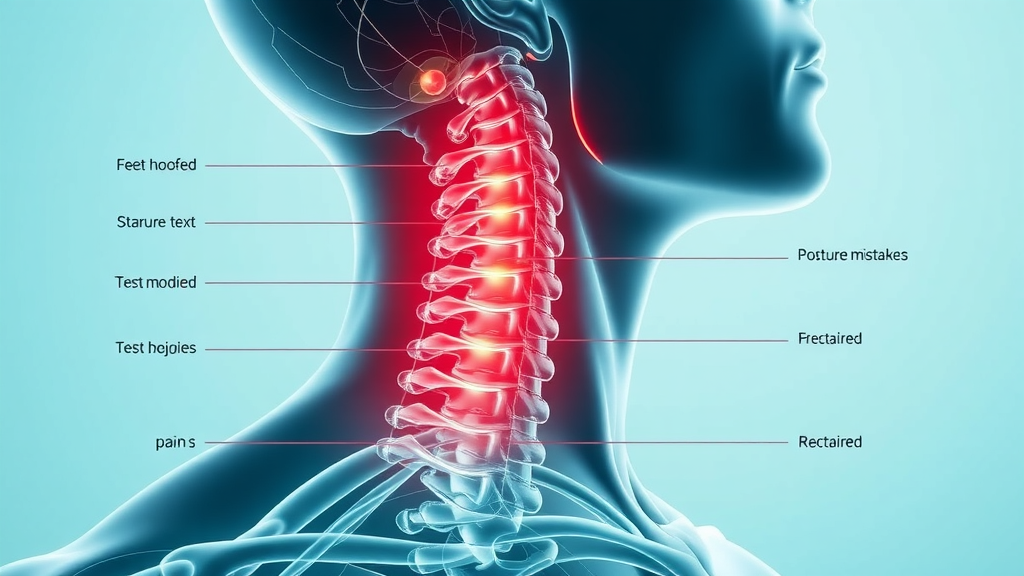Did you know nearly one in three adults suffers persistent neck pain each year? This eye-opening statistic underscores just how widespread—and urgent—the need for fast, accessible home remedies for neck pain has become. Whether it's the result of poor posture, tech neck, or hours spent in front of a screen, neck discomfort is more than a nuisance; for many, it can disrupt daily life and sleep. The good news? Relief is often within reach by using simple, science-backed remedies you can try tonight.
Staggering Neck Pain Statistics and The Urgent Need for Home Remedies
Did you know that nearly one in three adults suffers persistent neck pain each year? This alarming number highlights the urgent need for accessible, effective home remedies for neck pain.
Neck pain is a common issue affecting millions worldwide. The modern lifestyle—marked by long hours at desks, smartphones, and computers—has made stiff necks and discomfort in the upper back more prevalent than ever. Notably, research shows that up to 30% of adults will experience neck pain at some point each year, making it a leading cause for doctor visits and reduced productivity. This surge is largely attributed to poor posture, muscle strain, and repetitive stress injuries. With so many people impacted, it's no wonder that the search for reliable home remedies for neck pain is at an all-time high. Simple, at-home interventions can provide relief, reduce inflammation, and even prevent chronic pain when used correctly. If you're struggling with discomfort, learning how to relieve neck pain safely and effectively at home is more crucial than ever.

What You'll Learn About Home Remedies for Neck Pain
- Understanding causes and triggers of neck pain
- Effective home remedies for neck pain and stiff neck
- How to relieve neck pain safely at home
- Prevention strategies for chronic neck pain
- Answers to commonly asked questions about neck pain relief
Understanding Neck Pain: Causes, Symptoms, and When to Worry
Key Causes of Neck Pain and Stiff Neck
- Poor posture
- Muscle strain and overuse
- Injury and trauma
- Underlying medical conditions (e.g., arthritis, herniated discs)
Neck pain often begins innocently enough but escalates due to a range of common culprits. Poor posture—especially while working or scrolling on devices—places excess pressure on your neck muscles and spine, leading to persistent discomfort and even a stiff neck. Extended screen time or slouching can trigger muscle strain, while vigorous sports or sudden movements may cause acute injury or trauma. Furthermore, underlying conditions such as arthritis or herniated discs commonly contribute to neck stiffness, radiating pain, or chronic pain, often demanding both home remedies for neck pain and medical management. Identifying and addressing the root cause is the key to effective pain relief and long-term prevention of neck issues.
Symptoms You Should Not Ignore
- Severe pain unrelieved by rest
- Radiating pain or numbness in arms
- Weakness in neck muscles
While most neck pain responds well to simple at-home remedies, certain warning signs should not be overlooked. Severe pain that doesn’t improve with rest, pain radiating down your arms, numbness, or new muscle weakness may point to nerve involvement or more serious conditions such as spinal cord compression. Persistent stiffness, chronic pain unresponsive to over-the-counter pain relievers, or sudden changes in your ability to move your head warrant immediate attention. Recognizing these red flags ensures you don’t delay needed medical care and helps prevent further injury. Remember, your neck houses delicate nerves essential for overall health—when in doubt, always prioritize safety and consult your healthcare provider.
When to Seek Medical Attention
Most forms of neck pain can be managed at home, but if you experience any of the following symptoms, it is vital to seek medical care promptly:
- Pain persisting beyond a week or rapidly worsening
- Signs of infection such as fever or swollen glands
- Recent trauma or accident involving the neck
- Difficulty with coordination, walking, or bladder control
These signs may indicate deeper issues like spinal cord injury, severe muscle strain, or infection, and necessitate prompt medical evaluation. Even if you are trying home remedies for neck pain, understanding when to escalate care helps protect your long-term health and mobility.
Comprehensive Table: Common Triggers and Symptoms of Neck Pain
| Trigger | Examples | Common Symptoms |
|---|---|---|
| Poor Posture | Slouching, “tech neck”, sleeping awkwardly | Stiff neck, upper back pain, muscle tightness |
| Muscle Strain | Heavy lifting, sudden movement, sleeping wrong | Soreness, limited mobility, dull ache in neck muscles |
| Injury or Trauma | Sports accidents, falls, whiplash | Sharp pain, swelling, restricted motion |
| Chronic Conditions | Arthritis, herniated disc, spondylosis | Chronic pain, neck weakness, nerve symptoms (numbness, tingling) |

Top Home Remedies for Neck Pain and Stiff Neck
Apply Ice or Heat Therapy to Relieve Neck Pain

The application of ice or heat therapy stands out as one of the most accessible home remedies for neck pain. For new injuries or acute soreness, an ice pack helps reduce inflammation and minimize swelling, especially within the first 48 hours. Place an ice pack wrapped in a cloth on the affected area for 15-20 minutes at a time, several times per day. If your neck pain is chronic or you’re dealing with lingering stiffness, a heating pad or warm shower can promote blood flow, relax tight neck muscles, and provide immediate comfort. Alternating between ice and heat, depending on your situation, often delivers rapid pain relief at home. Always use both methods safely—avoid placing ice or heat directly on the skin and never exceed recommended application time to prevent burns or frostbite.
Gentle Neck Stretches and Mobility Exercises
"A few minutes of gentle neck movements each night can help relieve your pain and prevent stiffness."
Another effective way to relieve neck pain is incorporating gentle neck stretches and mobility exercises into your daily routine. Light movements such as chin tucks, shoulder rolls, and side-to-side rotations improve flexibility, encourage muscle balance, and support good posture. These exercises not only help alleviate acute symptoms of a stiff neck but also provide long-term benefits by preventing recurring pain. Gentle neck stretches should be performed slowly—never force movements—and stopped if pain increases. In just a few minutes each evening, you can significantly improve blood flow, reduce tightness, and support the natural alignment of your neck. Consistency is key; develop a stretching habit to both treat and prevent neck pain at home.
Over-the-Counter Solutions for At-Home Neck Pain Relief
When self-care and movement alone aren’t enough, over-the-counter solutions can be crucial for neck pain relief at home. Non-steroidal anti-inflammatory drugs (NSAIDs) such as ibuprofen or naproxen help reduce inflammation and manage discomfort. Topical creams containing menthol or capsaicin offer localized pain relief and a soothing sensation for sore neck muscles. Additionally, products like supportive cervical pillows or neck braces may temporarily help relieve pressure—especially overnight. However, use them wisely and avoid prolonged immobilization. Read all labels, follow dosage instructions, and never combine medications without guidance from a healthcare provider. Remember, while these remedies for neck pain can provide immediate relief, lasting improvement comes from addressing the underlying cause and maintaining healthy habits.
Massage and Self-Myofascial Release Techniques

Massage and self-myofascial release are highly effective for easing muscle knots and promoting relaxation. Techniques such as gentle finger kneading, foam rolling, or using a massage ball can improve blood flow, break up adhesions, and reduce muscle tension in the upper back and neck. For stiff neck relief, start with light pressure, slowly increasing as your muscles warm up. Aim to work alongside your spine and avoid pressing directly on bony areas. Self-massage, when done consistently, can help relieve the pain of daily stress and prevent neck stiffness. Consider partnering these techniques with mindfulness or deep breathing for even greater effect. For those new to self-myofascial release, it’s often helpful to watch instructional videos or consult with a physical therapist before starting.
Lifestyle Changes: Prevent Neck Pain and Support Healing
Improve Posture to Prevent Neck Pain and Stiff Neck
One of the most effective, long-term solutions to prevent neck pain is maintaining good posture. Slouching, leaning forward while on electronic devices, or hunching at a desk places excessive strain on your neck muscles and spinal cord, often resulting in tech neck and chronic pain. To protect your neck, keep your shoulders back, ears aligned with your shoulders, and your screen at eye level. Make it a habit to check your posture every hour—set reminders if needed. Small adjustments repeated throughout the day can drastically reduce your risk of developing a stiff neck, providing lasting pain relief at home. Regular posture checks, paired with ergonomic adjustments, can prevent neck pain and complement other home remedies for neck discomfort.
Ergonomic Adjustments at Home and Work

Long hours at a desk or working from home can quickly lead to neck stiffness if your setup isn’t ergonomic. Making strategic adjustments—such as raising your monitor to eye level, supporting your lower back with a cushion, and using an adjustable chair—can help relieve neck pain and encourage better body mechanics. Avoid cradling the phone between your ear and shoulder, and take breaks every 30-60 minutes to do a quick stretch or shoulder roll. If possible, consider a sit-stand desk to keep moving throughout the day. These changes, when paired with other home remedies for neck pain, can significantly lower daily strain and the risk of developing chronic pain in the neck and upper back.
Healthier Sleep Habits to Relieve Neck Pain
Proper sleep is essential for recovery and the prevention of neck issues. Sleeping on your back with a small pillow supporting the natural curve of your neck, or on your side with pillow support for both your head and arm, helps maintain good alignment. Avoid sleeping on your stomach, as this can twist your neck and strain the spinal cord. Choose a mattress and pillow that keep you comfortable yet supported. These simple changes, when integrated with home remedies for neck pain, can dramatically improve your quality of sleep and leave you waking up with less stiffness and discomfort each morning. Consistency is important; evaluate your sleep setup and planning regular adjustments for ongoing pain relief and neck support.
Healing Drinks and Nutrition: What to Eat and Drink to Relieve Neck Pain
"Hydration and anti-inflammatory foods can make a surprising difference in managing neck pain at home."
Soothing Teas and Beverages for Neck Pain
What you drink can directly impact your body’s inflammatory response and healing process. Soothing teas—such as ginger, turmeric, or chamomile—offer natural anti-inflammatory properties, helping to reduce swelling and discomfort in neck muscles. Hydration is equally essential; drinking water throughout the day flushes toxins, keeps tissues supple, and supports your body’s ability to heal. Try sipping warm beverages, especially in the evening, to relax tight muscles and prepare for restful sleep. In addition to teas, golden milk (warm milk with turmeric) and herbal infusions can be gentle yet effective home remedies for neck pain and stiff neck. Remember that combining these drinks with gentle stretches and proper posture multiplies their benefits.
Nutrition Tips to Prevent Chronic Pain

A nutrient-rich diet plays a powerful role in reducing chronic pain and promoting recovery from neck discomfort. Focus on anti-inflammatory foods such as leafy greens, berries, omega-3-rich fish, nuts, and seeds. These foods help reduce inflammation that exacerbates pain and support overall joint and muscle health. Avoid processed snacks, sugary drinks, and foods high in trans fats, as these can contribute to inflammation and slow healing. Maintaining stable blood sugar levels with regular, balanced meals aids muscle repair and decreases risk of recurring issues. By prioritizing nutrition alongside other home remedies for neck pain, you empower your body to heal more efficiently and help guard against future episodes of neck stiffness or chronic pain. Simple, consistent choices in your kitchen can have lasting benefits for your comfort and quality of life.
Chronic Pain: When Simple Home Remedies for Neck Pain Aren't Enough
Recognizing Chronic Neck Pain and When to Escalate Care
While most cases of neck pain resolve with basic home remedies, some individuals experience chronic pain—lasting weeks or recurring frequently. Signs that you’ve moved beyond typical muscle strain include pain that doesn’t improve with rest, ongoing numbness, tingling sensations, weakness in the neck muscles, or coordination problems. If you suffer from any of these symptoms, consult a physical therapist or care provider to rule out serious underlying conditions and receive a tailored treatment plan. Don’t ignore chronic neck pain; persistent discomfort can lead to permanent mobility issues and impact your daily activities if left unaddressed. Seeking professional help ensures you address the root cause, whether it’s a herniated disc, spinal issue, or nerve problem.
Combining Home Remedies with Professional Treatment
In cases where home remedies for neck pain are insufficient, combining them with professional treatment offers the best path to recovery. Physical therapy may be recommended to strengthen neck muscles, improve flexibility, and correct posture through targeted exercises. Therapists often use modalities such as ultrasound, electrical stimulation, or manual therapy in addition to guiding safe stretches. In some cases, medications or minimally invasive procedures may be necessary to resolve chronic pain or more serious injuries. Working closely with a care provider helps you develop an integrated plan—combining the benefits of pain relief at home and medical interventions—for sustained, long-term results. Always communicate your symptoms honestly and follow through with recommended therapies for optimal neck pain relief.
People Also Ask: Rapid Answers on Home Remedies for Neck Pain
How to cure neck pain fast?
To relieve neck pain quickly, start with ice or heat therapy—use an ice pack for acute injuries and a heating pad for muscle tightness. Perform gentle neck stretches, such as slow side-to-side rotations and chin tucks. Over-the-counter pain relievers like ibuprofen can provide additional comfort. Make sure to rest and avoid activities that aggravate the pain while ensuring good posture throughout the day. If rapid improvement doesn’t occur, consult a healthcare professional.
What is the best reliever for neck pain?
The best reliever depends on the cause, but commonly, a combination of ice or heat therapy, gentle stretches, topical creams, and NSAIDs provides significant relief for most mild to moderate cases. For muscle knots or tension, self-massage or myofascial release techniques offer targeted comfort. The most effective remedies for neck pain integrate movement, warmth, and anti-inflammatory supports for fast-acting and lasting results at home.
What drink helps neck pain?
Anti-inflammatory beverages like ginger tea, turmeric milk, and chamomile tea can help reduce neck pain by calming inflammation and promoting relaxation. Hydration—drinking plenty of water—is also crucial for muscle health and overall pain relief. Warm drinks may relax muscles and provide added comfort, especially when paired with nighttime stretching and proper sleep support.
What is the reason for neck pain?
Neck pain often results from poor posture, prolonged device use, muscle strain, or sleeping incorrectly. Injuries, such as whiplash or falls, as well as chronic conditions like arthritis or herniated discs, may also cause ongoing discomfort. Lifestyle habits, stress, and insufficient ergonomic setups further increase risk. Identifying your specific triggers helps guide the best home remedies for neck pain and prevention strategies for long-term health.
Frequently Asked Questions: Home Remedies for Neck Pain
-
Can I use essential oils to relieve neck pain at home?
Yes, some essential oils like peppermint or lavender, when diluted and gently massaged into the neck, may offer temporary relief. Always perform a patch test and avoid using directly on broken skin. -
Are foam rollers safe for neck muscle relief?
Foam rollers can be safe when used appropriately—stick to soft rollers, avoid excessive pressure, and do not roll over bony parts. If you’re unsure, start with self-massage using your hands or consult a physical therapist. -
How often should I stretch to prevent stiff neck?
Aim to stretch your neck gently at least two to three times per day, especially after long periods of inactivity or screen use. Consistent stretching helps maintain flexibility and reduces neck stiffness. -
What are signs that my neck pain is serious?
If you notice severe pain unrelieved by rest, numbness, tingling, weakness in arms or neck muscles, or neck pain following trauma, seek medical attention immediately.
Key Takeaways: What to Remember About Home Remedies for Neck Pain
- Immediate, simple remedies can offer relief for most neck pain at home.
- Prevention—especially through posture and ergonomics—is crucial.
- Seek professional help for chronic pain, nerve symptoms, or injuries.
- Nutrition and hydration play an underestimated role in recovery.
Conclusion: Start Your Home Remedies for Neck Pain Journey Tonight
Relief from neck pain is possible tonight with these safe, proven home remedies—take charge and make comfort your new normal.
Call Us for More Information on Home Remedies for Neck Pain
Call Us at 905-354-5153 for expert advice and personalized solutions on effective home remedies for neck pain, chronic pain relief, and prevention strategies that support your well-being.
 Add Row
Add Row  Add
Add 



Write A Comment